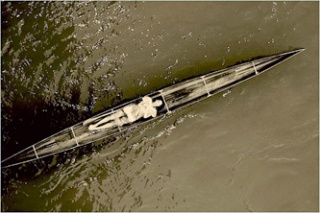A photographer of Swinomish and Tulalip descent, Matika Wilbur is participating in a show running May 30 – Nov. 29 at the Burke Museum of Natural History and Culture at the University of Washington.
The exhibit provides an opportunity for Northwest Indians to respond to the 1909 Alaska-Yukon-Pacific Exposition, which celebrated the explosion of development in Washington state since the 1897 Yukon Gold Rush. The exposition showcased the resources of the region, including representations of indigenous cultures from around the Pacific in ways that would seem abhorrent in 2009.
“It really was quite appalling what they did in the AYP,” Wilbur said.
She doesn’t want to “re-traumatize” the audience and strives to show the truth about her people.
“It’s frustrating to me that all the Indian art is represented by white gallery owners,” Wilbur said. “They don’t really differentiate the Tlingit and the Cherokee from the Coastal Salish people,” she said.
Wilbur strives to break the boxes of stereotypes and show the truth about her people. The images to be shown at the Burke are from her “We Emerge” series which was first presented to the public at the 2008 Folklife Festival.
A graduate of LaConner High School, Wilbur studied photography at the Rocky Mountain School of Photography and then enjoyed an opportunity with National Public Radio to go out and photograph indigenous peoples around the world.
“I ended up mostly in Ecuador and South America,” Wilbur told The Arlington Times from her Seattle studio.
“After that project, I decided I should photograph my own people,” she said, adding she did a collection of Swinomish elders, which the Swinomish Tribe acquired, and then the Tulalip, Samish and Nooksack tribes asked her to do the same for them.
“I asked the elders and thought a lot about what it means to be Indian,” she said.
“It was a real honor for me, a growing process,” Wilbur said, adding she is working on a new project, collaborating with other Indian artists to create a short film. She has now opened Gallery M in LaConner but continues to live and work in her Seattle studio.
The Burke Museum exhibit will juxtapose historic objects and photographs from the 1909 fair with contemporary artwork by Native artists to explore how representations of indigenous people and cultures have changed over the past 100 years.
Along with Wilbur, artists featured in “A-Y-P: Indigenous Voices Reply” include stone carver Tony Ayala (Santa Barbara Chumash), mixed-media Philip John Charette (Yup’ik), weaver MaryLou Slaughter (Duwamish), multi-media Nick Galanin (Tlingit/Aleut), glass by Preston Singletary (Tlingit/Filipino/European), multimedia artist Tanis S’eiltin (Tlingit), multimedia artist David Neel (Kwagiutl).
The curator of Native American art at the Burke Museum, Robin Wright explained the intent of the 2009 exhibit is to create a bridge between contemporary indigenous communities and the Burke’s collection of ethnographic objects from those communities.
“The exhibit is an opportunity for Native people to use the Burke’s collections to voice their sentiments on representation, resistance and revival,” Wright said.
The Burke Museum is located at the corner of Northeast 45th Street and 17th Avenue Northeast on the University of Washington campus.
The museum is open 10 a.m. to 5 p.m. daily and until 8 p.m. on the first Thursday each month, when admission is free.
General admission is $9.50, $7.50 senior, $6 youth. For information call 206-543-5590 or visit www.burkemuseum.org.


